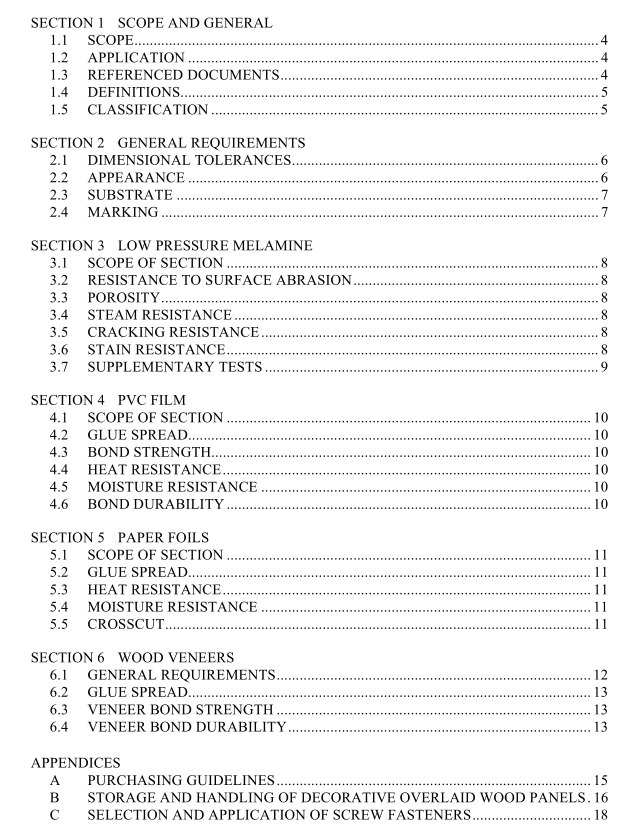AS NZS 1859.3 pdf download – Reconstituted wood-based panels— Specifications Part 3: Decorative overlaid wood panels

AS NZS 1859.3 pdf download – Reconstituted wood-based panels— Specifications Part 3: Decorative overlaid wood panels
6.1 GENERAL REQUIREMENTS
6.1.1 Veneer The veneer shall comply with the following requirements (see Clause 6.1.3):
(a) Each piece of veneer leaf shall be of sound timber, smoothly and tightly cut to a uniform thickness. Veneer thickness shall be 0.5 mm to 0.7 mm or as agreed between purchaser and supplier.
NOTE: Eucalyptus species often have gum veins and pin holes as an acceptable feature.
(b) Veneer leaf moisture content shall be in the range of 6% to 12% prior to making up into lay-on and also prior to pressing onto the substrate.
(c) Veneer leaf shall be cut such that the long edges or edges parallel to the grain are parallel and clean cut. Leaf shall be edge butt joined by suitable means to form a lay- on of the required grain pattern and dimensions.
NOTE: A veneer lay-on is made up of a number of pieces of veneer leaf, suitably matched for figure and colour according to purchaser requirements.
6.1.2 Panel forms Veneer panels may be manufactured in various forms based on veneer grades and end use requirements, as specified in Table 6.1.
6.1.3 Face grade veneers
In addition to the requirements in Clause 6.1.1, face grade veneers shall exclude the following:
(a) Open joints.
(b) Overlapping joints.
(c) Splits.
(d) Non-natural discolouration.
(e) Any other faults detrimental to the finish and appearance of the surface.
NOTE: Natural cracks and holes are permitted in some exotic veneers and burls. These may require attention during finishing.
6.1.4 Backing grade veneers
Backing grade veneers may be of lower quality than face grade veneers. The followingimperfections are permitted:
(a) Minor open joints, overlaps, knots, knotholes, splits and mismatching.(b)Mild discolouration.
(c)Natural blemishes such as gum veins and knots.
(d)Other minor faults that do not impair the integrity of the venecr.
NOTE: Patching of open defects with a suitable filler of matching colour can be arranged subjectto agreement between supplier and purchaser.
6.1.5 Adhesive
Adhesive used to bond the veneer to the substrate shall comply with the requirements ofAS/NZS 4266.2 and with the bond durability requirements according to the substratespecified.
6.1.6Construction
Venecred pancls shall be constructed as follows:
(a) Veneered panels shall be balanced, that is, generally the same species and thickness
of veneer shall be applied to both sides.
There may be occasions where purchasers’requirements call for differing species onthe face and back.These cases shall be subject to consultation and agreement betweenpurchaser and supplier.
(b)The grain of the veneer shall be generally parallel to the long edges of the panel.
There will be exceptions to this according to purchasers’requirements, e.g. diagonaland cross grain panels. In these cases, grain direction should be the same on bothsides where possiblc.
6.1.7Finish
Where trimmed, edges shall be clean cut and square to the surface. Sanded finish shall beequivalent to 150 grit or higher.
NOTE: Unsanded and untrimmed veneer panels may be supplied subject to agreement betweenthe purchaser and supplier.
6.2 GLUE SPREAD
Glue spread shall be continuous over the whole surface.6.3VENEER BOND STRENGTH
When determined in accordance with AS/NZS 4266.2,Veneer bond strength shall beconsidered satisfactory provided that——
(a) failure occurs in the veneer; or
(b)failure load exceeds requirements of Table 6.2.









